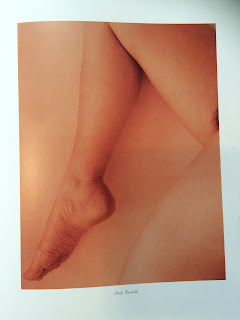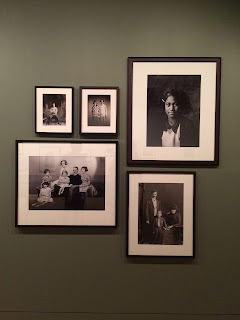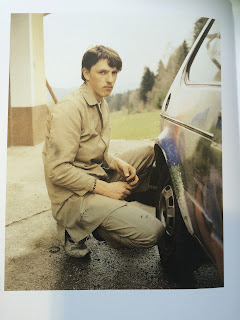While at Te Papa in the holidays I looked at the photography that was being exhibited. I was particularly interested in how the subjects were posed and lit. I also looked at how images were presented (hung, framed/not-framed etc) - I was particularly interested in how a series of images were hung in relation to each other (including the use of different sized images).
Saturday, 26 March 2016
Monday, 21 March 2016
4 x 5 Camera Introduction
It was really interesting to be shown a 4x5 camera and to learn a wee bit about how to use it, but I think I will just stick to digital photography for this paper as it is already new and challenging enough for me to have to photograph in the studio and figure out different ways of using light.
Guest Speaker - Stephen A'Court
“Start with a small idea and through experimentation make it better”
Tip: Make sure you have shadows so that the body looks three dimensionalisn’t flattened/washed out
http://photoboy.photoshelter.com/#!/index
Tip: Make sure you have shadows so that the body looks three dimensionalisn’t flattened/washed out
http://photoboy.photoshelter.com/#!/index
Sunday, 20 March 2016
Two More Inspiring Projects
"Seeing these features up close can feel like being let in on a secret.
Still, for all the openness and vulnerability of these bodies, the subjects of Melamed’s photographs are often turning away from her lens. One person looks above it, his green eyes hopeful and defiant, his cheeks scarred with acne and the barest hint of stubble. Another reticently turns his back and looks off to the side, as if he’s uninterested in returning the photographer’s gaze. One could read these photographs as a testament to the self-consciousness, the discomfort, or even the shame of trans-masculine people. Or one could see them as a compendium of refusals—the refusal to account for oneself, to “pass” as one thing or the other, to have one’s experience treated as a metaphor for individuality or transformation."
http://www.newyorker.com/culture/photo-booth/transgender-portraits-and-the-things-a-body-wont-tell
"Scars challenge the idea of beauty, that we should be flawless, especially in the age of photoshopping and the 'healing' tool to get rid of blemishes.
For her exhibition Flawed Landscapes, Marion photographed the scars of five women who underwent significant medical procedures.
Personal stories written by the women about what their scars mean to them accompany the photos.
Scars are connected to pain, trauma, humiliation, and shame: The idea of being 'not quite right'. There's the fear of not looking like the average unflawed person yet, in reality, everyone's got scars.
Marion said that people's enthusiasm to share their scar stories was about the desire of people to be heard and tell their story.
I think scars are beautiful because they're the story of us - they're the story of our lives."
Still, for all the openness and vulnerability of these bodies, the subjects of Melamed’s photographs are often turning away from her lens. One person looks above it, his green eyes hopeful and defiant, his cheeks scarred with acne and the barest hint of stubble. Another reticently turns his back and looks off to the side, as if he’s uninterested in returning the photographer’s gaze. One could read these photographs as a testament to the self-consciousness, the discomfort, or even the shame of trans-masculine people. Or one could see them as a compendium of refusals—the refusal to account for oneself, to “pass” as one thing or the other, to have one’s experience treated as a metaphor for individuality or transformation."
http://www.newyorker.com/culture/photo-booth/transgender-portraits-and-the-things-a-body-wont-tell
"Scars challenge the idea of beauty, that we should be flawless, especially in the age of photoshopping and the 'healing' tool to get rid of blemishes.
For her exhibition Flawed Landscapes, Marion photographed the scars of five women who underwent significant medical procedures.
Personal stories written by the women about what their scars mean to them accompany the photos.
Scars are connected to pain, trauma, humiliation, and shame: The idea of being 'not quite right'. There's the fear of not looking like the average unflawed person yet, in reality, everyone's got scars.
Marion said that people's enthusiasm to share their scar stories was about the desire of people to be heard and tell their story.
I think scars are beautiful because they're the story of us - they're the story of our lives."
http://eds.a.ebscohost.com.ezproxy.massey.ac.nz/eds/detail/detail?sid=762ee7ea-01d5-46f7-b3eb-4c2224e3ee39%40sessionmgr4005&vid=0&hid=4111&bdata=JnNpdGU9ZWRzLWxpdmUmc2NvcGU9c2l0ZQ%3d%3d#AN=P6S184174398716&db=anh
http://www.abc.net.au/news/2016-03-15/scar-photography-exhibition-castlemaine/7248596
http://www.abc.net.au/news/2016-03-15/scar-photography-exhibition-castlemaine/7248596
The History of Body Photography
“In every culture and across time, artists have been captivated by the human figure”
"The exhibition illustrates changing ideals of beauty and moral perceptions, and reveals once again the constant attempt to balance between educational openness, titillation and curiosity.
The origins of the history of nude photography lie in the so-called “academies“, which provided painters, graphic artists and sculptors with study objects in the 19th century and which followed the historical artistic models of Classical Antiquity and the Renaissance. Nude photography soon increasingly became emancipated from being a mere model for painting and sculpture, and developed artistic ambitions of its own: photographers discovered in the art of the fin de siècle, with its debt to Symbolism, the nude as a reflection of emotional states and yearnings. In the outgoing 19th century, with its bias towards the exact sciences, the human body served as an object for the study of movement, such as in the celebrated series shots by Eadweard Muybridge showing the sequence of motions in human movement.
Whereas historically staged scenes and compositions are still created in the sheltered environment of the atelier at the beginnings of photography, we find the first open-air nudes after 1870. Wilhelm von Gloeden, Guglielmo Plüschow and others took advantage of the light in the Mediterranean South to stage their visions of an earthly Arcadia. As a feature of the Lebensreform back-to-nature movement which gained ground from the turn of the century onwards, especially in Germany, nude photography became a torchbearer of the Naturist movement. The ornamentally arranged groupings of naked dancers which Gerhard Riebicke for example photographs, mainly in the German countryside, became a symbol for the liberation from the moral constraints of civilization and industrialization. The aesthetic of athletic bodies engaged in sporting activities or dancers in motion was taken up in the heroic physical ideal of the National Socialists and can later still be found in the cult of bodybuilding.
A new, more radical vision was developed by the Avant-garde movements after the 1920s, with their abstract and surrealistic experiments, such as the stories narrated in a play of light and shadow by František Drtikol or the deformed bodies in the works of Hans List. The theme of “glamour“ plays a crucial role above all in fashion photography. That chapter poses the question as to what role is played in the debate on fashion by the way of showing the unclothed female body, by male desire and how perceptions change in the course of cultural history. Glamour can be seen in the erotic images from the Atelier Manassé, shown in soft focus, in Bert Stern’s portraits from the “last sitting” of Marilyn Monroe, up to and including Helmut Newton’s photos.
The depiction of the naked torso is shrouded in an aura of scandal and has always been a political bone of contention, whereby images of the bare human body send signals which differ according to their historical context: the photographic artists of the 1970s, working within the framework of body art and performance events, declared the directness of their own physical experience to be a political necessity. In retrospect, their work can be seen as a last desperate attempt to grapple with the vanishing concept of the subjective personality before the transition to the post-modern age. The private spaces of life too are meanwhile also illuminated in a quite different way than 25 years ago. The photographer Thomas Ruff deals in his works, which he imbues with a diffuse haziness by digital means, with the theme of the exhibitionism which can go as far as pornographic exposure of one’s own and others’ nakedness in internet forums. Nude Visions shows that the representation of the naked human body always also has something to do with the quest for insight into what human beings (and one’s own self) really are and what role they play in society."
The origins of the history of nude photography lie in the so-called “academies“, which provided painters, graphic artists and sculptors with study objects in the 19th century and which followed the historical artistic models of Classical Antiquity and the Renaissance. Nude photography soon increasingly became emancipated from being a mere model for painting and sculpture, and developed artistic ambitions of its own: photographers discovered in the art of the fin de siècle, with its debt to Symbolism, the nude as a reflection of emotional states and yearnings. In the outgoing 19th century, with its bias towards the exact sciences, the human body served as an object for the study of movement, such as in the celebrated series shots by Eadweard Muybridge showing the sequence of motions in human movement.
Whereas historically staged scenes and compositions are still created in the sheltered environment of the atelier at the beginnings of photography, we find the first open-air nudes after 1870. Wilhelm von Gloeden, Guglielmo Plüschow and others took advantage of the light in the Mediterranean South to stage their visions of an earthly Arcadia. As a feature of the Lebensreform back-to-nature movement which gained ground from the turn of the century onwards, especially in Germany, nude photography became a torchbearer of the Naturist movement. The ornamentally arranged groupings of naked dancers which Gerhard Riebicke for example photographs, mainly in the German countryside, became a symbol for the liberation from the moral constraints of civilization and industrialization. The aesthetic of athletic bodies engaged in sporting activities or dancers in motion was taken up in the heroic physical ideal of the National Socialists and can later still be found in the cult of bodybuilding.
A new, more radical vision was developed by the Avant-garde movements after the 1920s, with their abstract and surrealistic experiments, such as the stories narrated in a play of light and shadow by František Drtikol or the deformed bodies in the works of Hans List. The theme of “glamour“ plays a crucial role above all in fashion photography. That chapter poses the question as to what role is played in the debate on fashion by the way of showing the unclothed female body, by male desire and how perceptions change in the course of cultural history. Glamour can be seen in the erotic images from the Atelier Manassé, shown in soft focus, in Bert Stern’s portraits from the “last sitting” of Marilyn Monroe, up to and including Helmut Newton’s photos.
The depiction of the naked torso is shrouded in an aura of scandal and has always been a political bone of contention, whereby images of the bare human body send signals which differ according to their historical context: the photographic artists of the 1970s, working within the framework of body art and performance events, declared the directness of their own physical experience to be a political necessity. In retrospect, their work can be seen as a last desperate attempt to grapple with the vanishing concept of the subjective personality before the transition to the post-modern age. The private spaces of life too are meanwhile also illuminated in a quite different way than 25 years ago. The photographer Thomas Ruff deals in his works, which he imbues with a diffuse haziness by digital means, with the theme of the exhibitionism which can go as far as pornographic exposure of one’s own and others’ nakedness in internet forums. Nude Visions shows that the representation of the naked human body always also has something to do with the quest for insight into what human beings (and one’s own self) really are and what role they play in society."
http://artdaily.com/news/40268/-Nude-Visions--150-Years-of-Nude-Photography--Opens-at-the-Museum-of-Visual-Arts--Leipzig#.Vu382seaLiY
Monday, 14 March 2016
Studio Lighting Session 14/3
Looking Further At Photographers I Found In My Book Research
Albert Watson
Greg Gorman
- I have selected all of these images because I like the poses and expressions of the subjects, and the lighting and framing/cropping of them.
Greg Gorman
- I have selected all of these images because I like the poses and expressions of the subjects, and the lighting and framing/cropping of them.
Book Research 14/3
 |
| Portraits: The World's Top Photographers And The Stories Behind Their Greatest Images. |
Michael Birt
"I am given an insight into their lives. However brief this glimpse may be, it allows me to see the qualities that make us all individual."
Greg Gorman
- I really like the poses of the subjects in these two photographs. I also like the lighting.
 |
| Portraits In Series: A Century Of Photographs |
Bernhard Fuchs
Hans-Peter Feldmann
- These images from these two photographers have got me thinking about how a subject can relate to their environment, and also how to pose and frame a location portrait.
 |
| The Photographic Portrait: Techniques, Strategies, And Thoughts On Making Portraits With Meaning. |
 |
| Nudes 3. |
 |
| Michael Darter - Twisting Torso |
 |
| Lisa Spindler - Bending Torso |
 |
| Lisa Spindler - Kinga Stretching |
 |
| Wendell Maruyama - Nude #47 |
 |
| Lee Friedman |
 |
| Malcolm Edwards - Gertrude |
 |
| Vic Huber - Alecia |
 |
| Malinda Kilmer - Untitled 4, From The Child Forms Series |
 |
| Duda Carvalho |
- I like the poses and lighting in these photographs.
Subscribe to:
Comments (Atom)





















































